Activity Versus Exercise
Activity versus Exercise: How to Cope with Pain Series
Exercise, of course, is good for you. Activity is good for you too. Both are helpful for those with chronic pain. Yet, they are different. They are not an equal substitute for the other. Let’s explain.
Activity
Patients often come to providers and, upon evaluation, respond affirmatively after being asked whether they engage in any regular exercise. When asked to describe their exercise routine, some folks go on to report various activities that they pursue through the course of their day. Still other times, they suggest that they get a lot of exercise because their employment involves being on their feet all day, such as with a retail sales associate, or engaged in other activities, such as the case of a carpenter or machinist.
Engaging in activities on a daily basis is important when self-managing chronic pain. It’s important because it fosters improved coping. The following list describes some of the numerous ways that remaining active helps people to cope with chronic pain:
- It provides a meaningful focus away from pain and focuses attention on other pursuits that have value in life
- Provides sources of self-esteem, as we tend to feel good about ourselves when we are productive in some way
- Provides sources of self-definition, as we often define ourselves by our occupation, hobbies, roles in the family
- Brings a sense of happiness and fulfillment when we pursue activities that we value
- Dispels the belief that chronic pain is a sign of injury and frailty, and instead reinforces a sense of confidence that remaining active despite pain is appropriate and healthy
The list isn’t exhaustive of all possible benefits of remaining active while living with chronic pain. However, these benefits, along with others like them, stand to reason. Who would argue that chronic rest and inactivity, along with its resultant lack of stimulation, boredom and lack of direction to one’s life, is good for anyone?
Empirical research backs up our rationally derived conclusions about the benefits of activity. Physical activity, along with its concomitant psychological stimulation, seems to change how the brain and spinal cord process signals from nerves in the body that could ordinarily be turned into pain (Naugle, et al., 2017). Those who maintain regular, stimulating physical activity tend to have less pain than those who remain passively inactive.
In another study, Pinto, et al., (2014) similarly found that higher levels of moderate-to-vigorous, leisure time activities were associated with reduced pain and perceived disability 12 months later. In other words, regular activity, rather than persistent rest, inactivity and lack of stimulation, is associated with less pain and improved coping.
Both common sense and science thus determines the truth of a standard maxim in chronic pain rehabilitation: that if you want to cope well with chronic pain, you must get up off the couch and go do something that’s stimulating, pleasurable or meaningful in some way, and preferably outside the house with other people.
Can we, or better yet, should we, count engaging in activities, such as most forms of work and play, as exercise?
Exercise
By exercise, we might define as repetitive bodily movements for the purposes of improving health, or physical and emotional well-being (Cf. Howley, 2001). Common types of exercise are stretching, core strengthening and aerobic exercise. Stretching involves the extension of various muscle groups, whereas core strengthening exercises attempt to increase control of abdominal and trunk muscles over the pelvis, with the goal of stabilizing the position of the spine (Hodges & Richardson, 1996). Aerobic exercise involves continuous use of large muscle groups that increases heart and breath rates (Pollock, et al., 1998).
Of course, everyone should follow the recommendations of their own healthcare providers, as each person’s health conditions can be different. However, a common form of exercise that is typically important for the management of chronic pain is mild, low-impact aerobic exercise.
Examples of gentle, low-impact aerobic exercise are walking, biking on land or on a stationary bike, use of an arm bike, and walking or swimming in a pool. These exercises are typically mild on the joints of the ankles, knees, hips and low back. So, in this sense, they are not rigorous and so most people with chronic pain can begin engaging in one of these types of exercises for at least a limited amount of time. Nonetheless, these exercises elevate the heart rate, which is what’s important and what makes them aerobic in nature. It’s also what makes these activities into a form of exercise.
With typical daily activities, we don’t elevate our heart rate for a continuous amount of time, which is what we do when engaging in aerobic exercise. When walking on land or in a pool or when riding a bicycle, our heart rate increases and continues at this elevated pace until we stop the exercise. This continuous elevated heart rate is what makes exercise an exercise and it’s what makes the difference between activities and exercise. Activities are meaningful and stimulating and engages attention away from pain, which is all well and good, but most activities don’t elevate heart rate in the manner that exercise does.
As such, activities are not exercise.
Some form of aerobic exercise is essential for successfully self-managing pain. When done on a regular basis, it reduces pain (Hauser, et al., 2010; Kroll, 2015; Meng & Yue, 2015). Likely, it does so by the effect that aerobic exercise has on the nervous system.
When we get a good, aerobic workout, our nervous system produces feel-good chemicals that produce a mild sense of euphoria and reduce our reactivity to stimuli that might typicaly affect us. For a period of time following the exercise, we have a sense of feeling mellow and things that normally bug us don’t bug us as much. The same goes for things that might typically cause pain. They don’t cause as much pain as they usually do. In this relaxed state, our nervous system is simply less reactive or sensitive. Runners call this experience a runner’s high. However, you don’t have to run to get it. Simply walking or biking or engaging in pool exercises can also do it.
When done on a repetitive basis, you lower the reactivity of the nervous system and thereby the things that used to cause pain don’t cause as much pain or come to cease causing pain all together. The less reactive nervous system simply doesn’t react to produce pain as it once did. In so doing, you can increase the threshold for what elicits pain through the intervention on the nervous system, which we call mild, aerobic exercise. In other words, you can reduce the degree of pain you have.
There’s a couple of important things to keep in mind.
One, the mild aerobic exercise must be done on a regular basis over time. It doesn’t have the described effect if you just do it once or twice, or if you do it only once in a while. There’s no exact number to quote, but a rough rule of thumb would be to engage in some type of mild aerobic exercise three to four times weekly on a continuous basis and after a number of weeks you’ll come to see some difference in pain levels. It won’t happen, in other words, over night in a dramatic manner. It occurs in a subtle manner over time. You might not even notice it at first, but at some point you’ll have a realization that your pain isn’t as bad as it once was.
Second, when starting out, you can easily do too much and as a result flare up your pain. This experience can be unpleasant and it can come to perform double duty as the perfect rationalization to stop your attempt to begin an exercise routine. It’s common for people to say in clinic that they tried to start an exercise routine, but that it hurt too much so they stopped exercising altogether. In beginning an exercise routine, then, it pays to start out slow and with a limited amount of time for each instance of walking or biking or pool exercise. Again, there’s no hard and fast rule to follow, but a combination of consultation with your healthcare providers and common sense can go a long way. Talk with your pain rehabilitation providers and come up with a modest beginning point and slowly, over time increase the length of time that you engage in the exercise. Perhaps, at first, it’s quite modest, so modest that you might not expect much pain relief. However, you’ve got a starting point from which you can slowly increase the time or rigor of the exercise as you get into shape. Over time, you increase the exercise to a point of rigor that really does provide benefit. So, it pays to consult with your pain rehabilitation providers to find a form of mild, aerobic exercise that works for you and to be patient in getting to a point that will really help you.
As we’ve said, engaging in some type of mild, aerobic exercise on a frequent and regular basis is essential for most people to self-manage chronic pain well.
Summary
In this post, we discussed two important things that most people with chronic pain do if they want to self-manage it well. They engage in meaningful and stimulating activities and they engage in a mild, aerobic exercise on a frequent and repetitive basis. We reviewed that activities and exercise are not the same. They each provide benefit in different ways. We described these benefits and reviewed some basics to get started. We also discussed the importance of seeking consultation with your pain rehabilitation providers when getting started. Along the way, we hopefully also motivated you to do both meaningful activities and some form of mild exercise.
By: Murray J. McAllister, PsyD












 Pain Scrambler MC-5A Scrambler Treatment is innovative pain treatment method especially for incurable chronicle pain treatment, besides neural pain and chronicle pain. is invented. Generally it applies to patients who are either dumb to all formal pain treatment and medicine treatment or careful of side effect of medicine, has no side effects, and can be expected to direct effective treatment effect.
Pain Scrambler MC-5A Scrambler Treatment is innovative pain treatment method especially for incurable chronicle pain treatment, besides neural pain and chronicle pain. is invented. Generally it applies to patients who are either dumb to all formal pain treatment and medicine treatment or careful of side effect of medicine, has no side effects, and can be expected to direct effective treatment effect.
 WSA UTAH State TV KSL-TV 5 News(2011.03.16)
WSA UTAH State TV KSL-TV 5 News(2011.03.16) NBC-TV 10 News USA Rhode Island State TV(2012.03.13)
NBC-TV 10 News USA Rhode Island State TV(2012.03.13) SBS News – TV
SBS News – TV


 Dr. Thomas Smith
Dr. Thomas Smith “Within 15-20 minutes of starting the therapy, my RSD pain seemed to diminish,” Stillitano wrote in her blog. “After treatment I went an hour and forty-five minutes with no RSD pain!!!!! It is so incredible to walk and not feel pain with every step.”
“Within 15-20 minutes of starting the therapy, my RSD pain seemed to diminish,” Stillitano wrote in her blog. “After treatment I went an hour and forty-five minutes with no RSD pain!!!!! It is so incredible to walk and not feel pain with every step.”